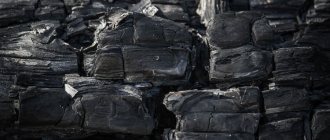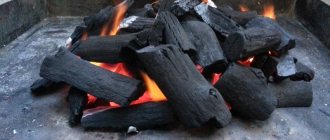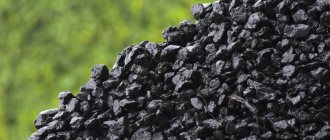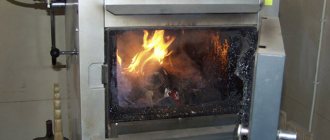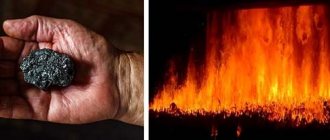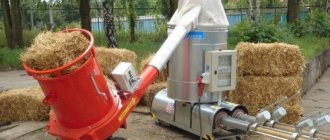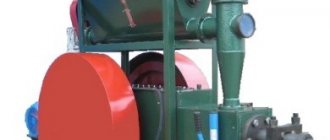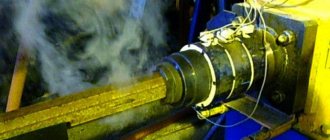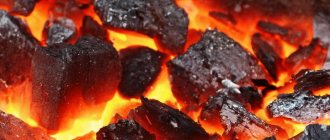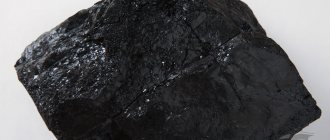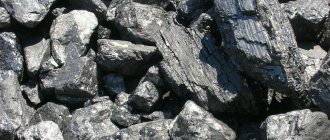Today, there are several types of solid fuels that are used as an energy carrier. Such fuel is: wood, coal, various fuel briquettes, as well as peat. Coal is considered the best fuel that can ensure the efficiency of a furnace or boiler. Today, charcoal is widely used, as well as fossil fuels. The popular charcoal is produced only artificially, namely through wood processing, but nature itself creates fossil fuels. Both types are widely used in some industries, as well as in everyday life.
Brown coal
It is the youngest type of coal. It even exhibits a plant-like woody structure. It is formed directly from peat at a depth of about 1 kilometer.
This type of coal contains a fairly large amount of moisture: from 20 to 40%. When exposed to air, it evaporates and the coal crumbles into powder. Next we will talk about the chemical composition of this particular dry residue. The amount of inorganic impurities in brown coal is also large and amounts to 20-45%. These impurities include silicon dioxide, aluminum, calcium and iron oxides. It may also contain alkali metal oxides.
This coal contains a lot of volatile organic and inorganic substances. They can make up up to half the mass of this type of coal. The elemental composition excluding inorganic and volatile substances is as follows:
- Carbon 50-75%.
- Oxygen 26-37%.
- Hydrogen 3-5%.
- Nitrogen 0-2%.
- Sulfur 0.5-3%.
Coal
This modification of coal is very rich in carbon, which leads to a high heat transfer coefficient and determines its use in the energy industry as the main fuel.
The formula of coal consists of bituminous substances, the distillation of which allows the separation of aromatic hydrocarbonates and a substance known as coke, which is widely used in metallurgical processes. In addition to bitumen compounds, coal contains a lot of sulfur. This element is the main source of air pollution when burning coal.
Coal is black in color and burns slowly, producing a yellow flame. Unlike brown coal, its calorific value is higher and amounts to 30-36 MJ/kg.
The formula of coal has a complex composition and contains many compounds of carbon, oxygen and hydrogen, as well as nitrogen and sulfur. Such a variety of chemical compounds became the beginning of the development of a whole direction in the chemical industry - carbochemistry.
Currently, coal has been practically replaced by natural gas and oil, but two important areas of its use continue to exist:
- the main fuel at thermal power plants;
- a source of coke produced by oxygen-free combustion of coal in closed blast furnaces.
Grill temperature
The optimal coal temperature for grilling shish kebab is 600-700°C [degrees Celsius]. It is with these indicators that the kebab turns out well-fried and juicy. Experienced barbecue makers determine the temperature by the appearance of the coals. The best temperature for frying is created when the coals begin to turn grey. That is, their surface is covered with a layer of white ash.
Important! Do not confuse the burning temperature of wood and the temperature emanating from coals.
That is, if you put birch wood in the grill and set it on fire, the temperature in the grill will reach 1069-1570° C. What is not acceptable for frying meat, it will simply burn.
Clue! Birch charcoal reaches the desired temperature [600-650°C ], just when the coals turn grey.
Wood burning temperature table
Role in history
People knew about the properties of coal in the distant past. Historians believe that it was first used for commercial purposes in China. There is evidence that an ancient mine in the northeast of the country provided this fuel for copper smelting and coin casting around the 1st millennium BC. One of the earliest records in Europe was made by the Greek scientist and philosopher Aristotle, who referred to coal as a stone.
Specific slags found among Roman ruins in England indicate extensive use of coal power before 400 BC. e. Chronicles of the Middle Ages provide the first mentions of not only the development of minerals by quarrying, but also their transportation by sea.
However, widespread mining began during the Industrial Revolution of the 18th–19th centuries. , when the demand for coal increased significantly. This was largely facilitated by James Watt's improved steam engine, patented in 1769. In addition, during this period the production of cast iron and steel, required for the construction of railways, machine tools and mechanisms, increased significantly.
Coal was also used to produce lantern gas. This type of lighting has become so widespread in large populated areas that the term “city gas” has been coined. London turned out to be the leader in the implementation of technology. Wider use was prevented by the advent of the electrical age, and since then the future of the mineral has become closely tied to the generation of electricity. The first operating station provided electricity for household lamps. It was developed by Thomas Edison and put into operation in 1882 in New York.
In the 1960s, oil overtook coal as the largest source of primary energy, with enormous growth in the transportation sector. Despite competition, it continues to occupy an important position in the global electricity generation structure, supplying more than a third of global demand. Large volumes of coking coal are used in the metallurgical industry.
Where is charcoal used?
The question often arises, where is charcoal used? In the distant past, this was the only source of fuel. In our time, it has not lost its position, and its scope of application has expanded significantly:
- Metallurgy
. The high carbon content makes it possible to use charcoal as a reducing agent, and the absence of sulfur and phosphorus guarantees the preservation of the necessary properties of the reduced materials. - Instrumentation
. Coal, which is obtained from soft wood, is used to make an anti-corrosion lubricant, which is needed for polishing and grinding various shapes and parts. - Construction
. Since this material absorbs odors well and is hygroscopic, coal is used as an insulator. - Animal husbandry
. This is an excellent feed additive that is introduced into the diet of calves, pigs, and birds. - Production of activated carbon
. It is used in many ventilation systems in order to trap volatile harmful impurities in the air. - Medicine
. Wood raw materials are used to make tablets and powders that help in the treatment of gastrointestinal disorders and poisoning.
Chemical process
After entering the chamber, gradual smoldering of the firewood occurs. This process occurs due to the presence in the firebox of a sufficient amount of oxygen gas that supports combustion. As the smoldering process occurs, a sufficient amount of heat is released and excess liquid is converted into steam.
The smoke released during the reaction goes to the secondary processing compartment, where it burns completely and heat is released. A charcoal kiln performs several important functional tasks. With its help, charcoal is formed, and a comfortable temperature is maintained in the room.
But the process of obtaining such fuel is quite delicate, and with the slightest delay, complete combustion of the wood is possible. It is necessary to remove charred pieces from the oven at a certain time.
Carboniferous wood
About 300 million years ago, during the Carboniferous period, most of the land on our planet was covered with giant fern forests. Gradually these forests died out, and the wood accumulated in the marshy soils on which they grew. Large amounts of water and dirt created barriers to oxygen penetration, so the dead wood did not decompose.
For a long time, newly dead wood covered older layers, the pressure and temperature of which gradually increased. Associated geological processes eventually led to the formation of coal deposits.
Anthracite
Anthracite is the oldest form of fossil coal. It is characterized by a dark black color and has a characteristic metallic sheen. This is the best coal in terms of the amount of heat it releases during combustion.
The amount of moisture and volatile substances in it is very small. About 5-7% for each indicator. And the elemental composition is characterized by an extremely high carbon content:
- Carbon over 90%.
- Hydrogen 1-3%.
- Oxygen 1-1.5%.
- Nitrogen 1-1.5%.
- Sulfur up to 0.8%.
More coal is contained only in graphite, which is a further stage of anthracite coalification.
Pyrolysis furnace: charcoal burning temperature
Charcoal is not a fossil at all. This fuel is produced by humans in special pyrolysis furnaces. The process of obtaining it is quite simple and consists of processing wood by pyrolysis. Simply put, you need to remove all moisture from the wood.
A pyrolysis oven has 4 main components: a very strong base, a combustion chamber, a secondary processing compartment and a chimney. The whole process takes place inside the combustion chamber, where it is necessary to constantly maintain the desired temperature and control the oxygen supply.
During the entire smoldering process, a lot of heat is generated, and moisture evaporates and evaporates. The smoke that is produced is recycled in a special compartment and burns completely there, generating heat.
Stages of producing charcoal:
- The critical stage is drying;
- The most important is pyrolysis;
- Then - calcination;
- And finally - cooling.
Charcoal begins to ignite at a temperature of 100 - 200 degrees, and flares up to 800 - 900. When it burns, a sufficient amount of heat is released that can warm the room.
What coal to choose for the fire?
What is coal? This is a product of plant origin, which contains carbons and non-flammable impurities. It is they who form ash and slag-like substances after burning. The ratio of the two components is different everywhere. It is this, as well as the “age” of natural fuel, that determines the grade of coal. Experts distinguish several varieties.
The “youngest” type of coal is lingite. It has a rather loose structure. If you pick up a lump of lingite, it will quickly crumble and lose its shape. This type of coal is most often used in thermal power plants, but lingite is not suitable for heating a home.
In addition to lingite, brown coal, hard coal, and anthracite are also mined - the most ancient carbon deposits. All varieties have different humidity levels. In brown coal, for example, humidity is 50%; in anthracite its threshold does not exceed 7%. Therefore, anthracite has the highest specific heat. Its indicators are 9 thousand kcal/kg.
Material for coal-fired stoves is the main criterion for choosing fuel and stove. Let's look at these qualities in more detail.
When the heating of the stove is successfully completed and the firewood is happily blazing in the firebox, all that remains is to monitor the thermal operating conditions and add new logs in time. As for the mode, it is recommended to maintain it constantly at the same level, avoiding overheating
This is important because alternating intense heating and cooling often causes the furnace body to expand and contract, causing cracks to occur.
Maintaining optimal thermal conditions and timely adding logs is the best way to properly heat a stove with wood, although it is not very convenient at night. No one wants to get up in the middle of the night, although if there is severe frost outside, this cannot be avoided, otherwise the house will be cold by morning. During continuous burning for several days, the ash pan has to be cleaned
to ensure the flow of air into the combustion chamber. The operation is carried out using an iron scoop at the moment when the bulk of the wood has burned out and a few firebrands remain in the firebox. You need to poke around the combustion chamber with a poker, cover the view, and then open the ash door and quickly remove the ash with a scoop into a metal bucket.
Important. There should always be a sheet of metal up to 1 m wide on the floor in front of the oven doors.
Regardless of whether coal or wood is used as the main fuel, ignition is performed in the same way. First, you should clean the ash chamber and firebox using a poker, dustpan and broom. After cleaning, do not forget to remove any remaining ash from the door hinges with a broom, otherwise they will not close tightly.
To light the stove, you must follow the instructions:
- Place several crumpled sheets of paper and several thin splinters on the grate. It is unacceptable to use liquid fuel for kindling;
- Use thin logs to fill approximately 2/3 of the firebox volume. Firewood can be stacked {amp}amp;house{amp}amp; or crosswise, making gaps for air. This is where the shorties mentioned earlier come in handy;
- open the view approximately halfway, open the blower door a quarter;
- Set the paper on fire through the open door of the main chamber, then close it. It’s good when you have a stove firebox with panoramic glass, then the process is clearly visible. If there is no glass, leave the door slightly open and observe the combustion, adjusting the air supply with the ash pan door. Usually, at first it is opened halfway, and when the wood flares up, it is closed.
Advice. In each specific case, the owner determines how much better it is to open the ash pan when igniting and burning, as well as the optimal position of the view. When the stove makes a hum, the draft is high and a lot of heat flies into the pipe, the valve should be closed. A red flame, smoke and sluggish combustion indicate a lack of traction, then the viewport opens slightly.
Formation and properties
Coal is a combustible mineral that is the modified remains of prehistoric vegetation that originally accumulated in swamps and peat bogs. The ancient flora was consolidated between other layers of sediment and transformed by pressure and heat over millions of years.
Thus, under the influence of physical forces, layers were formed and the composition of coal was formed, including carbon (90%), hydrogen (5%) and other minor impurities. Since carbon still predominates, the chemical formula of the substance is denoted by C, the first letter of the Latin word Carbo.
The origin of coal is confirmed not only by geological research and chemical analysis methods, but also by numerous finds. Imprints of the leaves of prehistoric ferns and living organisms are very often found in deep underground layers. Activated carbon is charcoal and has no relation to fossil fuels.
The formation of coal began during the Carboniferous period from 360 to 290 million years ago. The quality of each deposit is determined by the physicochemical conditions of formation and the duration of their influence, which is called “organic maturity.” This leads to the classification of the breed into several varieties (ranks) according to the degree of change:
- Peat initially turns into brown coal or lignite. Compared to other species, it is quite soft and crumbly, and the color varies from black to various shades of brown. Characterized by high levels of humidity and low carbon content, and therefore energy.
- Over millions of years, the maturity of lignite increases and it turns into subbituminous coals. In terms of the ratio of water and CO2 content, they are in an intermediate position.
- Further changes occur until bituminous coals are formed. They are quite hard and durable, and have a black glassy sheen.
- Under certain conditions, “ripening” reaches the quality of anthracite, which is characterized by the highest carbon content and low humidity. In terms of energy potential, this brand is the most productive.
The density of coal varies depending on its rank and the content of mineral impurities that reduce the calorific value. This indicator is important for determining enrichment methods (removal of impurities).
Relative density is measured as specific gravity, which is the ratio of the mass of an object to the mass of an equal volume of water at 4 °C. This indicator for water corresponds to one, which means that materials with a specific gravity of less than 1 do not sink. Since the value varies depending on the rank, it can be determined for different grades of coal:
- anthracite - 1.47;
- bitumen - 1.32;
- subbituminous - 1.3;
- brown - 1.29.
These figures are directly related to the enrichment process because impurities significantly change the standard characteristics. For example, the specific gravity of pyrite (fool's gold), a common impurity and major source of sulfur in coal, ranges from 4.9 to 5.2. Because pyrite is much denser than coal, density separation methods are used to remove it.
Application
The main use of fuel is to burn it to produce heat. Heat is used not only for heating a private home and cooking, but also in industry to support technological processes that occur at high temperatures.
Unlike a conventional stove, where the process of oxygen supply and combustion intensity is poorly regulated, in industrial stoves special attention is paid to controlling the supply of oxygen and maintaining a uniform combustion temperature.
Let's consider the basic scheme of coal combustion.
- The fuel heats up and moisture evaporates.
- As the temperature rises, the coking process begins with the release of volatile coke gases. When burned, it provides the main heat.
- Coal turns into coke.
- The coke combustion process is accompanied by the release of heat sufficient to initiate coking of the next portion of the fuel.
In industrial boilers, the combustion of coke is separated into different chambers from the combustion of coke oven gas. This allows the flow of oxygen for coke and gas at different intensities, achieving the required combustion rate and maintaining the required temperature.
Coal combustion formula: two types of fuel
When combustion of any fuel, wood or coal, occurs, a chemical reaction occurs, resulting in the formation of heat. There is an equation for this reaction, which results in the formation of carbon monoxide (formula CO). The combustion does not end there; the whole process rises, where the reaction between carbon monoxide and oxygen occurs. Then combustion is expressed by a bright blue flame and, along with this, heat is released.
Carbon monoxide, which is formed at the end of the entire combustion process, escapes through the chimney. The heat generated as a result is evenly distributed throughout the room. Fuel is used to achieve this result.
Fuel (coal) is divided into two types: short-flame and long-flame. Long-flame fuel can burn in two stages. The first stage is the combustion of volatile gases formed above the coal layer, and then the remaining fuel in the form of coke. Coke burns with a distinctive short flame. As a result, after all the carbon has burned out, slag and ash remain.
Short flame fuel:
- Coke;
- Anthracite;
- Charcoal.
When burning a short-flame type, a large amount of heat is generated. Short-flame anthracite burns odorless and smokeless, without forming a residue, and is also characterized by a low flame.
Extraction methods
The choice of extraction method depends on geological and natural conditions, the availability of infrastructure, economic and social prerequisites. The main attention is paid to the following factors:
- quantity, quality, thickness and angle of inclination of layers, depth of their occurrence;
- the nature and thickness of interstratal sedimentary rocks;
- features of surface relief;
- accessibility of transport, energy networks and processing enterprises;
- environmental consequences;
- form of ownership of the land plot and its current use.
All this data serves to determine the profitability of the future enterprise, and also helps to make a choice between surface and underground mining. An analysis of world production shows that in terms of quantitative indicators, both methods are approximately equal, but depend on the type of coal:
- anthracite accounts for about 10% of world production and is mined underground;
- lignite seams (25%) are most often extracted from quarries;
- bituminous coals (65%) are mined by both methods in approximately equal proportions.
The open method is considered cheaper and less dangerous, but very harmful to the environment. It is used in cases where the fossil lies at a depth of no more than 100 m. Coal is extracted from quarries using special equipment: graders, bulldozers, excavators and heavy-duty dump trucks. The height of some machines can be compared to a multi-story building.
The most valuable grades of coal are developed using a closed method, and this justifies the economic costs associated with the construction and operation of mines. For example, the most valuable anthracite is lifted from a depth of more than 1.5 km. This technology consists of drilling a vertical shaft, from which horizontal and inclined workings are diverted, leading to productive formations. Mining work has always been very dangerous due to collapses, methane emissions and difficult conditions, but nowadays it is increasingly automated and coal mining combines and other equipment take the place of people.
Heating with coal - practical advice
Complete combustion of coal fuel requires a special approach to the issue. The task is to achieve maximum efficiency of the heat source, not to overheat the coolant and not start a fire due to too high a temperature.
Anthracite is the highest calorific coking coal
We suggest taking into account our recommendations for choosing equipment:
- It is not advisable to heat purely wood-burning boilers and factory-made steel stoves with high-calorie coals - stone and anthracite. Powerful heat transfer and strong heating can deform the walls of the firebox (usually they are made 3 mm thick).
- TT boilers with water-filled grates are not suitable for coal heating. Due to the temperature difference, the hot sintered layer tightly sticks to the water pipes, making air passage and further cleaning of the unit very difficult.
- If you have calibrated coal with a fraction size of 25-50 mm (classified as walnut), the best choice would be a boiler with automatic fuel supply. The unit is equipped with a retort burner and a fan that precisely meteres the air injection at the command of the electronics. Duration of continuous operation – up to 7 days.
- The ideal option is to buy a mine or traditional boiler designed to use coal. The heat generator is equipped with movable grate bars, rotated by an external handle. The device helps to dump ash from the firebox into the lower chamber.
- Heaters equipped with a fan or smoke exhauster are more convenient and safer than boilers with mechanical regulators on a chain. If the temperature rises critically, the automation will turn off the air supply and the channel will be closed by a damper. The usual blower cover does not fit tightly, oxygen seeps into the chamber, and slow combustion continues.
- Heating an open fireplace with coal is a futile exercise. You won’t get much heat, you’ll just spread dirt in the room and an unpleasant smell will appear.
- To increase safety, it is highly advisable to install an additional thermal relief valve on the boiler. In case of overheating and boiling, the element discharges part of the coolant from the boiler jacket and simultaneously fills it with cold tap water.
You need to get used to each type of coal. It is better to add unfamiliar fuel in small portions, adjusting the draft with a damper and watching the temperature rise. When you have calculated all the combustion nuances of a given brand, fill the firebox 2/3 full.
An important point regarding the operation of a brick oven with a stove. Never open the burners after loading a new portion of coal; use the side door. If there is a lack of oxygen, the fuel releases pyrolysis gas, which will come out through the moved burner.
The largest coal deposits in the world
The first country in the ranking in terms of the amount of coal mined annually is the United States, Russia is in second place.
Map of coal deposits in the world (click to enlarge)
In the United States, the most famous coal basin is the Illinois. The total reserves of deposits in this field amount to 365 billion tons.
Next comes the Ruhr Basin, located on the territory of modern Germany. All deposits and basin development sites are under strict protection.
Problem solving
The task is simple
In the furnace of a steam engine, 50 kg of coal was burned, the specific heat of combustion of which is 30 MJ/kg. How much heat was released in this process?
Solution
The problem statement contains all the necessary data, so we convert it to SI and substitute it into the formula.
SI is the international system of units. “Convert to SI” means converting all quantities into meters, seconds and other units of measurement without prefixes. The exception is the kilogram with the prefix “kilo”.
We convert the specific heat of combustion to SI:
30 MJ/kg = 30,000,000 J/kg
Substitute the values into the formula:
Q = qm = 30,000,000 50 = 1,500,000,000 = 1500 MJ
Answer: 1500 MJ was released during the combustion process.
Application of hard coal in industry
For hard coal used in industry, GOST 32464-2013 is applied - a decree that describes technical requirements, methods for determining the chemical composition, and classification according to various parameters.
The use of the fossil is based on the pyrolysis reaction of coal - heating without any reagents. In modern industry, various chemical additives are increasingly used to speed up the reaction. Pyrolysis stages:
- condensation;
- polymerization;
- aromatization;
- alkylation.
Separately distinguished:
- Low-temperature pyrolysis occurring at 500–600 °C. This is semi-coking.
- High temperature process, or coking. It runs at 900–1100 °C.
All coking products are divided into 3 groups:
- Solid - coke. Used in ferrous and non-ferrous metallurgy.
- Liquid – coal tar. More than 250 chemical compounds are obtained from it. The main ones are technical oils, synthetic fuels, naphthalene, benzene, ammonia. Dyes, TNT and saccharin are made from toluene.
- Gaseous – pyrolysis gas. Alternative source of energy and heat.
When processing fossils, the following products used in industry can be obtained:
- vanadium, sulfur, zinc, lead;
- xylene and benzene - used in the paint and varnish industry;
- solid fuel used to heat houses and ensure the operation of enterprises;
- liquid fuel - obtained by liquefying solid fuel;
- illuminating gas used for lighting;
- ash - used in construction.
The fossil belongs to the 4th hazard class, as a flammable substance capable of heating.
For personal use, fossils are used to generate heat. Where there is little wood or it is difficult to prepare firewood, you can heat the bathhouse with coal. Many houses still have stoves. Premises heated with coal warm up well and are acceptable even for harsh winters.
Lighting coal is not easy - you need an armful of firewood, wood chips or splinters, straw, paper. First, several firewood are laid, chips (splinters) are placed on them, and straw is placed on top. They set fire to the paper and use it to set the straw on fire. Then the wood gradually lights up. The rest of the firewood is added as space becomes available. When it's hot, they put in coal. The preparation process pays off with a long combustion time and good heat transfer.
Coal ash is not used as a fertilizer - it contains few nutrients and may contain heavy metal impurities. The only acceptable solution is to use it on highly alkaline soils to normalize acidity - ash acidifies the soil.
Some people suggest grilling shish kebab on it, but you shouldn't do that.
We invite you to watch a foreign program about the situation with mineral resources in Europe:
Fuel types
A person really needs heat for all life processes: for example, for heating a home, cooking, melting metals and obtaining other types of energy. To obtain heat and light, a person uses fuel. When people first made fire, they couldn’t do without fuel either - they used wood.
A fuel is any substance that releases energy during combustion.
There are four groups of fuels:
- solid fuel,
- liquid fuel,
- gaseous fuel.
In fact, there is a fourth group - nuclear fuel, but in this case the mechanism for obtaining energy is different. We talked about it in an article about a nuclear reactor.
Solid fuels include :
- wood,
- oil shale,
- coal,
- peat.
Fossil solid fuels, other than shale, are a product of the decomposition of organic plant matter. Peat is the youngest of them; it is a dense mass that was formed from rotted swamp plants. Not so young anymore (let's say, middle-aged
